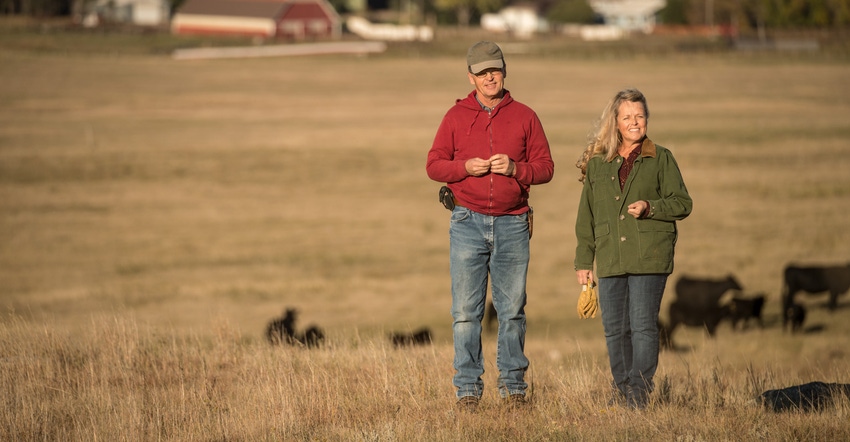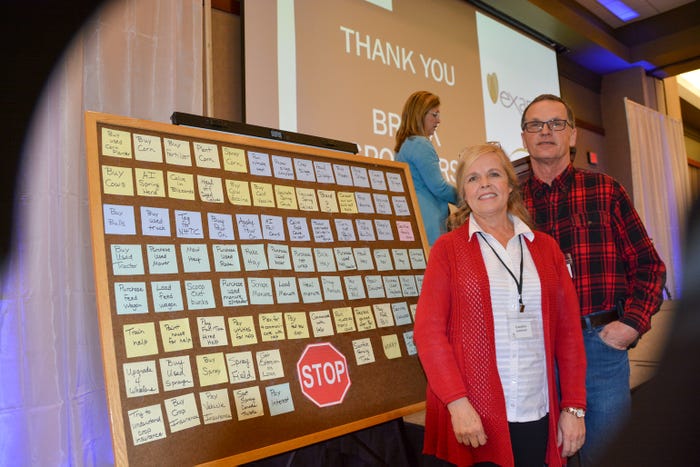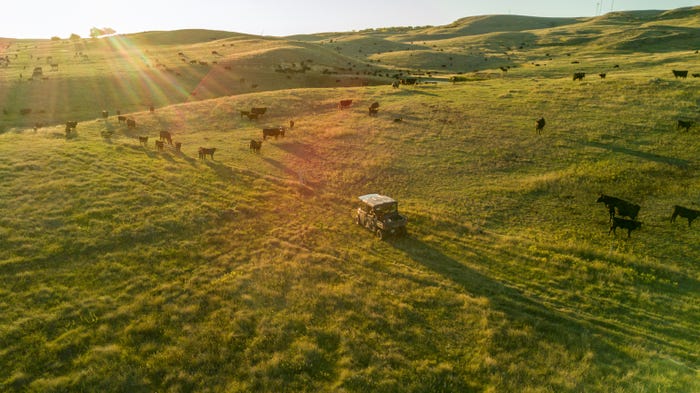
Dean and Candice Lockner, of Thousand Hills Ranch, Ree Heights, S.D., embraced one of Albert Einstein’s ideas when they set out to make their farm and ranch more profitable and resilient.
“We can't solve problems by using the same kind of thinking we used when we created them,” Einstein said. He revolutionized scientific thought with new theories of space, time, mass, motion and gravitation.
The problems the Lockners were trying to solve were more down to earth than Einstein’s, though. In fact, they were all about the earth — excessive water erosion from their farm ground, overgrazed pastures, unproductive soils and ever-rising input costs.
Erosion problems
The Lockner’s farm and ranch straddles the Ree Hills, which rise 300 feet above the prairie in central South Dakota. Like Candice’s parents who managed the land before them, she and Dean farmed the flatter ground and ran cattle in the hills.
 STOP DOING IT: Candice and Dean Lockner show a bulletin board cover with post-it notes listing the jobs they have stopped doing since converting cropland to grassland and adopting holistic and regenerative agriculture practices. The Lockners spoke at the 2020 South Dakota Soil Health Conference.
STOP DOING IT: Candice and Dean Lockner show a bulletin board cover with post-it notes listing the jobs they have stopped doing since converting cropland to grassland and adopting holistic and regenerative agriculture practices. The Lockners spoke at the 2020 South Dakota Soil Health Conference.

The Lockners were bothered by the water runoff that was occurring on their farm ground. So much water was moving that it caused wash outs on gravel roads adjacent to their property. They practiced minimum tillage and chisel plowing rather than moldboard plowing, but it did little to slow the topsoil loss from the slopes and the washouts in the roads.
Minimum tillage didn’t do anything to improve soil organic matter or increase the biological life in the soil, either. Their crop yields fluctuated widely due to poor soil health, according to Dean.
Back to grass
In 1990s, Dean and Candice tried a new approach. Instead of applying more inputs to their cropland in attempt to produce profitable yields, they began converting cropland to grass. Over several years, the converted grasslands gradually became much more productive than they had been as cropland.
 DYING WEEDS: Candice reaches for a dying Canada thistle plant. The Lockners use grass competition, grazing pressure and biological tools to control weeds.
DYING WEEDS: Candice reaches for a dying Canada thistle plant. The Lockners use grass competition, grazing pressure and biological tools to control weeds.

Filled with deep prairie grass roots and microbial life, the soil absorbed more water than it had when it was used to grow crops. Runoff from heavy rains and snowmelt was nearly eliminated.
“The forage production was amazing, too,” Dean says.
Eliminating unprofitable
Eventually, the Lockners converted all their cropland to grass. As they narrowed their focus to their livestock enterprise, they eliminated practices that didn’t pay or were too labor intensive.
For instance, they stopped calving twice a year — once in early March-April and again in September — and moved to a single calving period in May-June. They stopped selling club calves, which required that they AI cows with semen from good show bulls. They stopped trying to stockpile large amounts of hay and grazed their cattle as long in the winter as possible to reduce fuel and labor costs.
When they brought cows in and fed them hay, they strip grazed and bale grazed them in nearby pastures, moving the cows to new areas frequently to rejuvenate the soil with the carbon from the wasted hay and the animals’ manure.
They didn’t spray pasture weeds with herbicide. They used electric fencing to create smaller paddocks where they forced the cattle to graze or trample weeds, and they started using biological weed control.
“We've seen incredible results controlling Canada thistle with gall flies, a rust fungus and the introduction of stem miner weevils,” Dean says. “The most effective tool for weed control is a healthy competitive stand of desirable grasses and forbs.”
They stopped applying fertilizer with a tractor and spreader, as well. Instead, their cattle added manure to the soil.
The Lockners also divided their large pastures into many smaller units. They rotated cattle through them rapidly to mimic how bison grazed the Ree Hills before fences were erected by farmers.
“Our management now involves looking at our grass and cattle and thinking about how we can work with Mother Nature,” Dean says.
Lessons learned
The Lockners say they have learned to look to nature for solutions to problems on the land, and they learned to be more patient and flexible. Patience, they say, is important because it takes time for the land to heal.
“Short-term patience produces long-term pay offs,” Candice says.
Management flexibility is important because there is no production formula or recipe that the Lockners follow each year. They don’t graze the same pasture first every year. They don’t cycle through the pastures the same way every year. Grazing and rest periods vary with grass conditions and stocking rates.
 GREEN HILLS: The Lockners drive a UTV into a pasture to check cattle. They divided their large pastures into many smaller units and rotate cattle through them rapidly to mimic how bison herds grazed the open prairie.
GREEN HILLS: The Lockners drive a UTV into a pasture to check cattle. They divided their large pastures into many smaller units and rotate cattle through them rapidly to mimic how bison herds grazed the open prairie.

The number of cattle they run on their ranch varies widely, depending on the condition of the grass and the market. In severe drought years, they don’t have any cattle; other years they have as many as 750 head. Some years, even when they have cattle, they stockpile grazing. Sometimes they cut the grass and bale it so they have hay to sell.
The Lockners don’t even market their calves the same way every year. Sometimes they wean calves before they sell them, while other times they sell light calves directly off the cows.
“We no longer do something because it’s the way we’ve always done it,” Dean says. “Every year is different.”
One constant
The Lockners say their one constant is their happiness. They are enjoying the new harmony they have found working with nature. They also have much more time to spend with their children and grandchildren.
For a presentation at the 2020 South Dakota Soil Health Conference, the Lockners showed a bulletin board covered with post-it notes of the many of jobs they no longer have to do since they converted farmland to grassland and adopted holistic, regenerative production practices.
“It has been life-changing for us,” Dean said.
Watch the video below to see the Lockners’ presentation at the 2020 South Dakota Soil Health Conference.
About the Author(s)
You May Also Like






